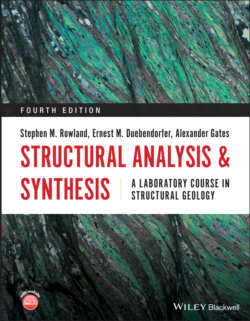Читать книгу Structural Analysis and Synthesis - Stephen M. Rowland - Страница 30
Determining Outcrop Patterns with Structure Contours
ОглавлениеIf an important planar horizon is exposed in three places on a topographic map as in Figure 2.13a, its outcrop pattern can be determined on a topographic map. This is done by using the three‐point solution and locating the intersections of the structure contours with the topographic contours. This is accomplished using the following technique:
1 Draw structure contours parallel to the line B–B′ (Figure 2.10d). In order to determine the outcrop pattern, these structure contours must have a contour interval equal to (or a multiple of) the contour interval on the topographic map. Because the surface is planar, the structure contours are a series of straight, equidistant, parallel lines. The spacing can be determined using the interpolation described or using:Figure 2.12 Technique for drawing a cross section. The top diagram is a map with surface and structure contours and the bottom is a geologic cross section. Transfer points to corresponding elevations on the topographic profile. Transfer two or more structure contours to another sheet of paper. Connect points to complete the cross section.In this example, the spacing (d) is 17.5 ft in map view (Figure 2.13a). Point B is at an elevation of 160 ft, which is conveniently also the elevation of a topographic contour. Points on the bedding plane with known elevations (points A and C in this problem) serve as control points to make sure that the elevations of known outcrop points match their elevations on the structure‐contour map. Figure 2.13b shows the completed structure‐contour map.
2 On the superimposed structure‐contour map and topographic map (Figure 2.13c), every point where a structure contour crosses a topographic contour of equal elevation is a surface outcrop. The outcrop map is made by marking each point where topographic and structure contours of the same elevation cross. Connect the points of intersection to display the outcrop pattern on the topographic map (Figure 2.13d).
This same technique can be used to locate a second surface that is parallel to the first. If the contact shown in Figure 2.13d is the top of a bed, we can determine the outcrop pattern of the bottom of the bed as well. If a single outcrop point on the topographic map is known, then the outcrop pattern can be found using the structure‐contour map already constructed for the bed's upper surface as follows:
Figure 2.13 Determination of outcrop pattern using structure contours. (a) Three structure contours on a base map (from Figure 2.10c). (b) Structure‐contour map. (c) Structure‐contour map superimposed on a topographic map. (d) Outcrop pattern of a plane on a topographic map.
Figure 2.14 (a) Structure‐contour map from Figure 2.13 shifted such that the 200‐ft structure contour lies on point Z. Point Z is a point where the bottom of a layer is exposed. The top of this same layer is exposed at points A, B, and C from Figure 2.11a. (b) Outcrop pattern of this layer, which dips 30° to the southeast.
1 Position the structure‐contour map beneath the topographic map such that the bottom surface outcrop point (or points) lies (lie) at the proper elevation on the structure‐contour map. With the structure contours parallel to their former position, proceed as before. In Figure 2.14a, point Z, at an elevation of 200 ft, is an outcrop of the bottom of the bed. The structure‐contour map has been moved so that the 200‐ft structure contour passes through point Z, and the predicted outcrop points have been located as before.
2 Once the upper and lower contacts are drawn on the topographic map, the outcrop pattern of the bed can be shaded or colored (Figure 2.14b).
